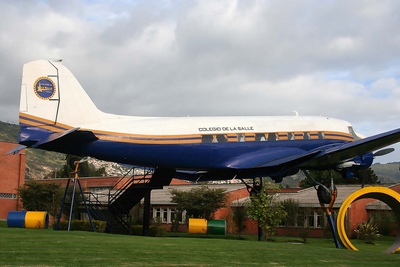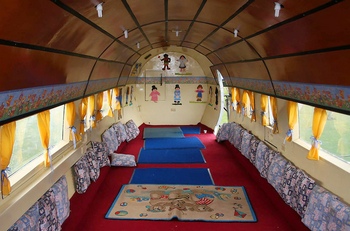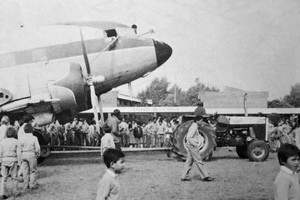A DC-3 Classroom in Bogotá
The Aircraft
In April and May of 2008 I received some interesting photos from Javier Franco Topper, an aviation enthusiast and photographer from Colombia. They were of a beautiful DC-3 that was in use as a classroom at the Colegio De La Salle, a school in the northern suburbs of Bogotá, Colombia.
Javier went on to tell me that according to someone at the school the aircraft had been donated to the school about 25 years ago, by the Fuerza Aérea Colombiana (FAC, the Colombian Air Force), but that nothing else was known about it. He asked me if I was able to fill in the many blanks... Since then, several others who also visited Bogotá have asked the same question, which prompted me to put together this webpage.
At first this seemed a simple thing, because Javier had already done the most important bit: he had been inside the DC-3 and had already photographed the data plates, which show the serial number of this aircraft.
In this case the manufacturer's original plate was no longer there, but instead there was a plate from the United States Army Air Forces (USAAF). This very clearly showed the DC-3 to be a C-47A, serial number 42-92867. It also showed the USAAF order number W535AC28405, which was indeed the contract number under which C-47A 42-92867 was built at the Douglas plant in Oklahoma City, OK, way back in 1944. Everything seemed to fit.
But there was a problem. When I checked the history for this C-47A, I found almost nothing. By far the best source for this kind of information is undoubtedly the book "DC-1/2/3 - The First Seventy Years" by Jennifer Gradidge, published by Air-Britain (Historians) Ltd. in 2006.
This book showed that USAAF serial number 42-92867 was manufacturer serial number (msn) 12715. This number would have been stencilled on the manufacturer's original data plate, had that still been present in the aircraft. The book also showed that 42-92867 was delivered to the USAAF on 09 March 1944, and then went to the Mexican Air Force on 19 September 1947. But there the history ended.
This was odd. It is very unusual for an aircraft to completely disappear and then suddenly show up again in very good condition 60 years later! So what had happened here?
Cause of Confusion
As it turns out, the problem was caused by the number "12726" at the bottom of the USAAF plate, where it says Date Accepted (see photo). It is unclear what this number means or why it is there, as it is obviously not a date.
When this aircraft was imported into the US from Mexico in 1956, the aircraft's owners used this spurious number 12726 to register their aircraft with the Civil Aeronautics Authority (CAA, now the FAA). Consequently, on 19 March 1956 our mystery aircraft was entered into the US civil aircraft register as N47F, with incorrect serial number 12726, instead of 42-92867. A few months later the registration was changed to N75T, but the incorrect serial number remained. In fact it was never corrected, and today, more than 50 years later, it is still on the USCAR with the wrong number.
What made matters worse is that there is a C-47A which really has serial number 12726. This particular aircraft was delivered to the USAF only three days later than our mystery aircraft, with USAAF serial number 42-92877. In 1956 it was still operational with the USAF, and based at Rhein-Main AFB near Frankfurt, West Germany. It continued to fly actively in military service until 1970.
The author of the Air-Britain DC-3 book was aware of this discrepancy. How could an aircraft that was still flying with the USAF as late as 1970, be registered as a civil aircraft in 1956? This is why the book adds a note to the history for msn 12726, which says:
"Note: c/n 12726 was inserted in FAA records for N47F, but 42-92877 was originally given. However, the dates overlap with USAF use, so we are looking at two aircraft."
A correct conclusion, but what was the identity of that second aircraft? Well, it seems we may have found it now.
Two Aircraft: Combining Histories
As mentioned previously, I was surprised to see no further history for C-47A 42-92867 c/n 12715 after 1947 in the Air-Britain DC-3 book. This has now been explained, because the remaining history ended up with C-47A 42-92877 c/n 12726.
There it says that the aircraft became XB-VUT, N47F and N75T (in July 1956), and adds that it was fitted with large Viewmaster windows (indicated by "[V]"), also in 1956. This was usually done as part of a larger conversion. The book goes on to list several owners of N75T, ending with LKB Resources from Huntingdon Valley, PA, as of 02 January 1974.
LKB Resources as an owner is significant, because this company was active in the field of aerial surveying, performing (amongst other activities) aerial gamma-ray & magnetic reconnaissance surveys during the mid and late 1970s. DC-3 N75T was one of their aircraft, and for that purpose it had been equipped with various kinds of survey gear, such as a tail-mounted MAD boom.
Following the LKB Resources ownership, the Air-Britain DC-3 book mentions a further sale of the aircraft to an unknown party in 1981 (which is still recorded in the FAA database today, see here), and then suggests that it was scrapped. No further info is offered.
But, if we are correct about all this, how did N75T end up in Colombia? Perhaps this obscure sale in 1981 has something to do with it?
Confirmation of a Theory
But first it would be nice to obtain some form of independent confirmation of all this. DC-3 historian Matthew Miller greatly helped in this, by comparing photos of the aircraft at Bogotá with photos from his archives, showing N75T in the mid or late 1970s. This comparison showed that both aircraft have the:
- same horseshoe aerial on top of the fin, which is fairly rare.
- same aerial on the roof between the first and second window.
- same large Viewmaster panorama windows, at least on the left hand side.
- same profile of the nose radome.
- same rear door, which is hinged at the bottom instead of at the side.
In addition to this, Javier photographed a second data plate, which was from Remmert-Werner Inc. from Lambert Field, St. Louis, MO. This plate confirms that they converted this aircraft to civil DC-3C standards with an executive interior on 25 June 1956. Such a conversion often included the large Viewmaster windows, which were also visible in the old photos of N75T.
All this seems to be rather convincing already, but there's more. Javier's photos of the Colegio De La Salle DC-3 clearly show an odd closeout plate on the rear fuselage below the rudder, which is very uncommon. Most DC-3s have a small tail cone or a recess where the tow gear assembly once was. This closeout plate is an unusual modification which indicates the removal of MAD survey gear.
This does indeed fit perfectly with N75T having been used as an aerial surveyer by LKB Resources Inc. They did have N75T fitted with tail-mounted MAD gear, and the closeout plate was apparently added when this gear was removed.
Finally, I received an interesting document from Colombia. It was from the Dirección Nacional de Estupefacientes (DNE, the Colombian drugs enforcement agency), dated 05 June 2008, and listed a large number of aircraft, cars and boats which had been impounded for drugs-related issues over the years in Colombia. An Adobe PDF extract of this document, which only lists the impounded aircraft, can be downloaded here.
This document does indeed mention N75T, and describes it as a DC-3 with a green and white colour scheme. This ties up nicely with the colours worn by N75T during its service with LKB Resources, which consisted of a blue cheatline separating a greenish belly from a white top (see photo on the left).
According to the document, the aircraft was impounded in Maicao in the La Guajira district in northern Colombia, by the Unidad Especializada Antinarcóticos Maicao of the Policía Nacional. Although the document is a bit brief on this point, it appears to indicate that N75T was later transferred to the Ministerio de Defensa Nacional/Policía Nacional - Dirección General in Bogotá, after which it was cancelled from DNE records.
It is somewhat unfortunate that the document does not mention any dates, but it does confirm that N75T did indeed end up in Colombia, and that it almost certainly ended its active career there.
Conclusions & The Full Picture
From all these facts we can now draw two separate but equally important conclusions:
- The DC-3 at the Colegio De La Salle in Bogotá is N75T.
- This N75T is and always has been c/n 12715 ex 42-92867, and not c/n 12726 (as quoted by the FAA and all other sources).
The latter conclusion of course means that N47F and XB-VUT (as mentioned in the Air-Britain DC-3 book) are also c/n 12715, and not 12726.
So, now that we have established the aircraft's identity, and corrected the previously recorded identity of N75T, N47F and XB-VUT in the process, let's go back to Javier's original question about the historical details for the aircraft which currently stands so beautifully preserved at the school in Bogotá. Here they are, taken from various sources (with special thanks to John M. Davis):
- Built in Oklahoma City, OK, as C-47A-15-DK c/n 12715 (contract AC-28405)
- 09Mar44: delivered to USAAF as 42-92867.
- 19Sep47: to Mexican Air Force, probably serialled TTD-6007 or TTD-6008.
- Nov53: sold to Servicio Aeronáutica de México SA as XB-VUT.
- circa 1955: sold to Rómulo Antonio O'Farrill (Mexican television and newspaper entrepreneur)
as XB-VUT.
- 19Mar56: regd to Beldex Corp. (St. Louis, MO) as N47F.
- 25Jun56: converted to civil/executive configuration by Remmert-Werner Inc. (with Viewmaster windows).
- 08Jul56: reregd to N75T.
- 11Jul56: regd to Dow Chemical Co. (Midland, MI).
- Aug62: to Brown Oil Tools Inc. (Houston, TX).
- Mar70: regd. to Lloyd M. Bentsen Jr. (Houston, TX).
- May72: to Kreck Aviation Co Inc. (Windom, TX).
- 02Jan74: regd to LKB Resources Inc. (Huntingdon Valley, PA). Aerial survey aircraft.
- 01Mar74: Certificate of Airworthiness issued for aerial surveying.
- 24Feb81: regd to Manufacturers Trust Co. Inc. (New York, NY).
- Feb81: Sale reported (Miami, FL).
 |
This view of N75T clearly shows the two large Viewmaster windows on the right side of the aircraft. Photo taken on 9 May 2008, by Javier Franco Topper. Click on the photo for a larger image. |
Apparently this unknown Miami-based company used N75T for drugs trafficking activities in Latin America during the early 1980s. One such flight went wrong, and the aircraft was impounded by the Colombian authorities at Maicao, La Guajira, Colombia. Some time later they moved it to Bogotá, and subsequently donated it to the Colegio De La Salle. There it still stands today, almost 25 years later, beautifully repainted and still in very good condition.
Who would have thought that a former military transport, aerial surveyer and drugs-running aircraft, would make such a wonderful classroom at a Colombian school, for so many years...
If you want to know exactly where to find this immaculate aircraft, have a look at this satellite imagery on the Google Maps website.
Update April 2010
On 23 April 2010, Javier Franco Topper was able to visit the school in Bogotá again, and received some interesting bits of new info about their DC-3.
The aircraft arrived at the school in March 1987, still in its original colours as seen in the above photo of N75T in 1980. It had been in storage Base Aérea de Madrid for about three years, and it was towed over the road from there all the way to the school, a journey of about 40 kms. Click here to see some photos of this memorable event.
As it turns out, the aircraft could not be donated to the school, because it was still tied up in legal investigations dating back to when it was confiscated as a drugs-running aircraft circa 1983. Officially it is therefore still owned by the Fuerza Aérea Colombiana, but they entered into an agreement with the school for its safe-keeping. The school will take good care of the aircraft while it is in their hands, which includes a repaint about every four years.
Thanks
First and foremost I want to thank Javier Franco Topper, for informing me about this aircraft and for taking the trouble to photograph the data plates. Without those wonderful photos there would not have been anything to solve.
Many thanks also go to aviation historians John Davis and Matthew Miller, who very enthusiastically helped me to get to the bottom of this issue. Their knowledge and insights continue to amaze me!
Finally I would like to thank Guus Ottenhof for the kind use of his rare photo of N75T as an aerial surveyer in 1980.
Other sources used in the compilation of this webpage are:
- DC-1 / DC-2 / DC-3 - The First Seventy Years, by Jennifer Gradidge
- AMCAR Quarterly Review, Issue 15, August 1981, p.43
- Dirección Nacional de Estupefacientes (Ministerio del Interior y de Justicia, Bogotá, Colombia)
- Colegio De La Salle website







